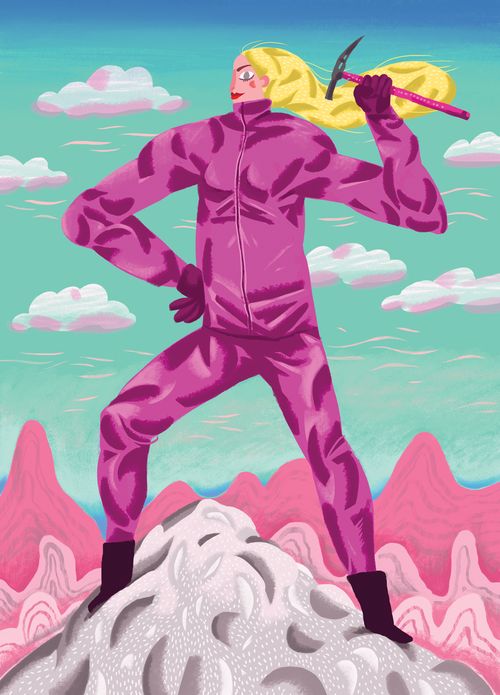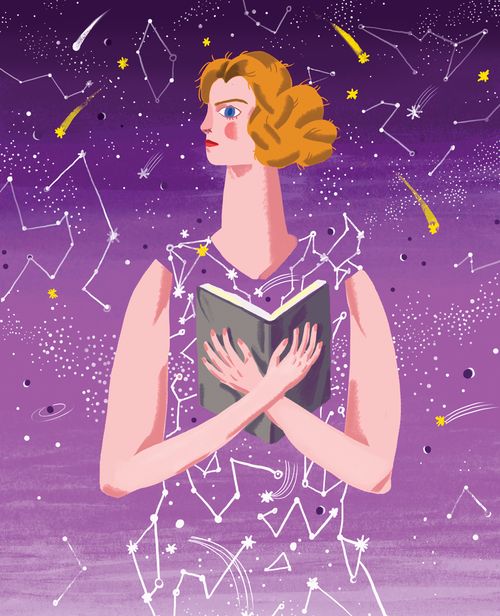A hot yellow cover immediately catches your eye. It shows two girls joining hands and holding a paintbrush and a wrench. One of them is in a dress, the other in pants, and they both smile. The idea of the illustration is clear: it is about the right to choose, feminine solidarity, and that there is no field in which a woman cannot achieve success. The proof of this is 50 life stories of the Ukrainian women who made a name for themselves in totally different spheres. All of them – both historical figures and our contemporaries – have met on the pages of the book The Power of Girls: Little Stories of Great Deeds by Kateryna Babkina and Mark Livin.
The book was recently published by Knyholav on the initiative of Internews and with financial support from the government of Canada. The book’s print run is 5,000 copies. It will be distributed free of charge in school and children’s libraries of Luhansk and Donetsk oblasts, among migrant children, the families of ATO veterans and of those killed and missing in action, and through volunteer organizations. It will not be on free sale so far, but publishers say they are mulling over a commercial edition because of a brisk demand.

“THE BOOK SHATTERS THE MEDIA MYTH THAT IT IS MEN WHO USUALLY ACHIEVE SUCCESS”
The book is about very different women. Children (and not only they) will perhaps hear about some of them for the first time. It is a plus. The book discloses or, to be more exact, returns the names of the women who made a contribution to history but were forgotten or underestimated. It comprises the life stories of writer Lesia Ukrainka and Princess Olha, doctor Sofia Okunevska and traveler Sofia Yablonska, academic Olena Kazymyrchak-Polonska and designer Varvara Karynska…
What also appeals to me is the idea to include some of our contemporaries in the book: actress Ada Rohovtseva, film director Kira Muratova, writer and artist Emma Andiievska… Incidentally, the book also includes the stories of women who, maybe, are not so recognizable, but they inspire by their example and prove that to be successful means not only to be well-know, but also to do one’s favorite job, overcoming all the obstacles.
Take, for example, the story of volunteer Iryna Havrysheva who suffered from about 30 serious diseases and whom doctors expected to die soon. But, instead, she enjoyed life and helped others. Or the story of teacher Hanna Dudich who is pronounced as one of the planet’s best pedagogues… Or the story of Crimean Tatar civil society activist Vedzhie Kashka, and many others…
So, as Mark Livin emphasized quite to the point, “The book shatters the media myth that it is usually men who achieve success.”
“I WISH GIRLS TO UNDERSTAND FROM AN EARLY AGE THAT THEY ARE STRONG”
“A little girl had both of her feet amputated due to an incurable disease. But this did not hinder her from making her way up, owing to right upbringing and persistence. Her name was Olena” – thus begins the story of biathlete Olena Yurkovska.
“It honors and pleases me greatly. I am glad to be a role model for somebody. I wish people would not fixate too much on their defects and bashfulness. I myself went through this, and when I began to go in for sport, I understood that I didn’t have to be afraid. I was teased and called names in school because I had my feet amputated at the age of 2.5. But, thanks to sport and a dream to achieve something in life, I overcame my fears, including the fear of society,” Olena told The Day. “Among women, the best role model for me is my mum. She is my inspiration.”

The book also tells the story of Oksana Yakubova who fought in the east for three years. “It is very much unexpected for me to get into a book like this. But I want readers to know that, although war is a hard job for adults, girls have also occupied a place they deserve in this war. There are no jobs that women can’t do as well as men. I wish girls to understand from an early age that they are strong,” Yakubova explains to The Day.
CHANGING THE WORLD FOR THE BETTER CONTRARY TO CIRCUMSTANCES
What deserves special note is illustrations by Anna Sarvira and Yulia Tveritina. All the portraits are modern and uncommon, bold and visually interesting.
“I was trying to make very diverse portraits and experimented with techniques. I wanted to show that all the heroines are different, they lived at different times and were busy doing different things,” Sarvira says. “While working I understood that there are some difficult moments because the stories of many women are not so simple, and this should be shown in the illustration. It was difficult, albeit inspiring, to do so.”

Knyholav will soon publish the Ukrainian translation of Good Night Stories for Rebel Girls, a world bestseller about outstanding women by Elena Favilli and Francesca Cavallo. This book in fact inspired the publishers to bring forth a book about Ukrainian women. It is written in the introduction to The Power of Girls: “It is the first collection of stories about Ukrainian girls who, even contrary to rather than thanks to society, circumstances, traditions, and sometimes even their families, have changed and continue to change this world for the better.”
It is the first and, fortunately, not the last, children’s book about prominent Ukrainian women. Just a month later, Vydavnytstvo will publish the book She Did It, in which several authors tell about 55 outstanding Ukrainian women. The fact that there emerge more and more books of this kind is only of benefit to little readers, both boys and girls.
THE POSTSCRIPT OF A READER
The book’s idea, visual design, and selection of heroines – everything is up to the mark. We must thank the project curator Kateryna Kotvitska for this. It is also difficult to overestimate the role of such books for little readers. These books are important and in demand, and they should be written and published.
But there are some things that should be taken into account when The Power of Girls will be reissued. Firstly, it is absence of the sources of information. They are a must in non-fiction books. Another point is absence of explanations and footnotes. One must remember that the readers of this book are children who may not know what NKVD, UN mission headquarters, etc., is. Of course, it is difficult to tell children, particularly in brief, the life story of artist Alla Horska or the 87-year-old mathematician Nina Virchenko. But this is the author’s task. Besides, the narration is practically without dates. It is easy to understand the justifiable intention to avoid a large number of them in order not to turn a story into a school-style biography. But it would be a good idea to include the main dates at least for one to be able to know in what period the heroine lived and why she did things one way and not another.
It would be also good to have more stories about deeds, not just biographies. There should be interesting details, apt quotations, something that would inspire and explain how the heroine achieved success. Some stories have this, which turns then to advantage, and some do not. The stories about our contemporaries are particularly short of this. Hence, the authors have a nice opportunity to learn about everything directly from the book’s heroines.
In spite of this, the book is surely worth reading. It should be read by girls and boys, children and adults.







